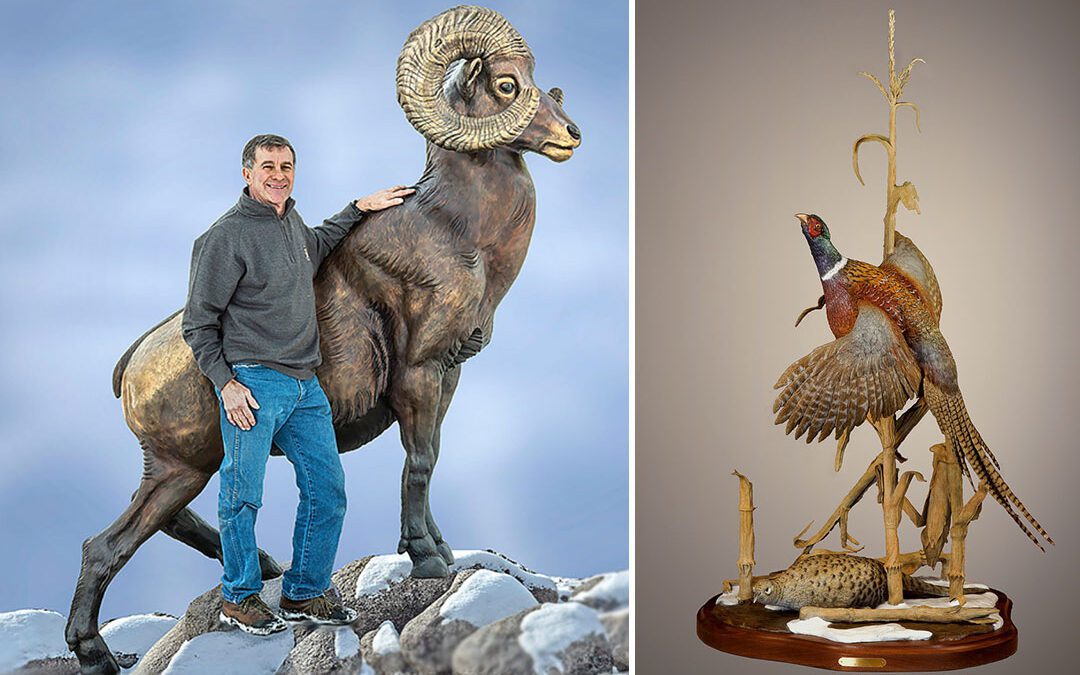SPONSORED CONTENT
For Fred Boyer, there is no separation between living a rich outdoor sporting life that has little to do with money and celebrating it in a way so that we, the viewers, literally feel the texture of what he’s expressing in our hands. If Boyer’s not away on safari somewhere in Africa or Asia, he might be fishing the Montana streams near his porch that Norman Maclean made legendary in his novella, “A River Runs Through it.”
Fred Boyer is a soft-spoken man who hails from the rough-and-tumble, former copper smelting town of Anaconda (where he still lives). He spent several youthful summers working as a Forest Service smokejumper battling western wildfires, and then became a beloved high school art teacher before he finally figured out what he wanted to do with the rest of his days. Astoundingly, that was 40 years ago.
For Boyer, retirement has never figured into the grand plan, certainly not when a guy can still carry a 60-pound backpack, scale a ridgeline a dozen miles from the nearest road, and bury one’s hands into the pliable mass of modeling clay.
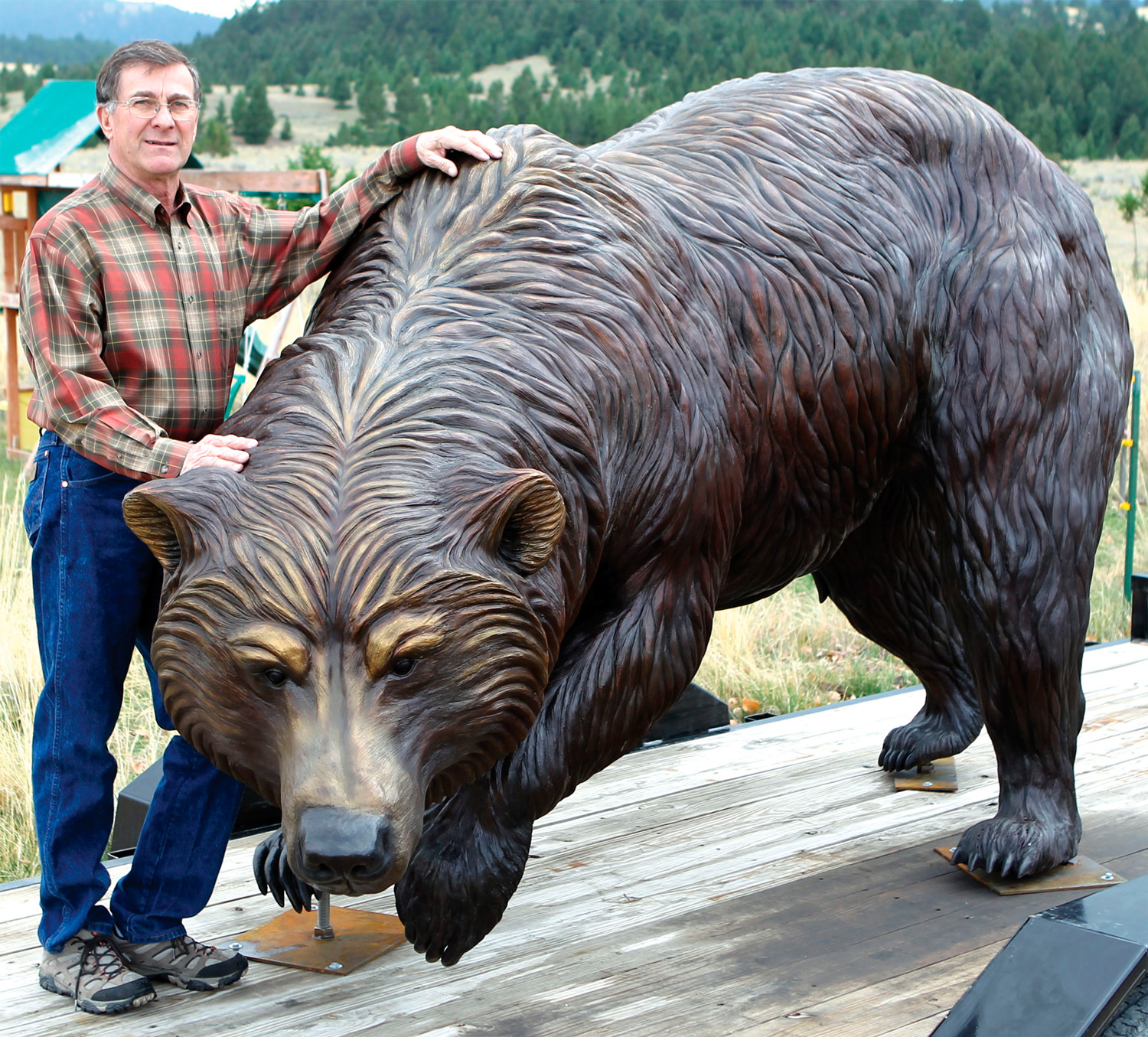
“Fresh Sushi” 10’6″ x 5’4″ x 4’4″ | Edition 10
Boyer is particularly proud of his many years as a professional bear guide in southeast Alaska. In addition to his spring and early summer bear hunts, Boyer once taught drawing classes in Sitka, where he was revered for having an uncanny ability to locate bruins on the ABC islands. Many of the massive, salmon-filled brown bears top 1,000 pounds and measure more than 10 feet from snout to hindquarters. When one rises three feet in front of you on hind legs to whiff-scent your presence, it’s a pose one never forgets, Boyer says.
There is no such thing as catch-and-release bear hunting and Boyer chalks up 99 percent of his encounters to valuable non-lethal field research in which he also encouraged his clients to study the nuances of individual animals before taking a shot.
When they’re successful, Boyer the bear scout turns into Boyer the anatomist, who by readying hides for shipment to a taxidermist uses the opportunity to understand musculature and physiology in ways that other contemporary animal sculptors often do not.
Boyer’s many seasons in Alaska, however, were merely a prelude for the one he craves most – autumn in western Montana where his memories go back a half-century.
Boyer’s work is popular among sportsmen because he captures the mystical allure that keeps summoning us back to wild country. He knows his wild subjects well, especially the world’s most popular big game animals.

“Autumn Royalty” 13’6″ x 9’6″ x 6′
One of his most spectacular bronze sculptures is a Rocky Mountain elk that weighs more than a ton. Titled Autumn Royalty, the larger-than-life-sized bull wapiti carries antlers that are tilted heroically skyward and a mouth agape in full bugle. Truth be told, he says, the actual seven-by-seven, 400-plus Boone & Crockett qualifier that inspired his sculpture doesn’t reside as a stuffed head in someone’s trophy room.
“The rack on that bull was modeled after a real shed antler found in the Big Hole of Montana,” Boyer says. “All that I was able to get my hands on was just the one side. I would love to see the whole spread moving through the mountains on the head of the live animal.”
On all of his hunts, even on his African safari, Boyer was hands-on, helping to remove the capes and skins so he could examine the musculature of both predators and prey in order to create sculptures that are amazingly true to life.

“Black Magic” 30″ x 21″ x 17″
One of several bronzes he created after his safari was Black Magic, which features two sable antelope in full flight. He observed these animals in Mozambique where he was among the first party of sportsmen to hunt in the country in the previous 24 years.
Boyer’s realistic sculptures, identifiable for their colorful, hand-painted patinas, are known to collectors of sporting art around the world. All of his creations were inspired by personal encounters Boyer has had with big game animals and birds. Collectors of his art include major league baseball Hall of Famer Wade Boggs, former President George W. Bush and the late four-star General H. Norman “the Bear” Schwarzkopf.

“Limiting Out” 77″ x 32″ x 14″
For those seeking a fully informed verdict on the quality of his work, there’s probably no one more enthusiastic than retired Montana District Court Judge C.B. McNeil, who along with his wife JoAnn have amassed the largest private collection of Boyer sculptures.
McNeil recalls a conversation he had with a Montana game warden as they stood before some of Boyer’s sculptures at an art show.
“I can’t remember exactly what the animals were that we were looking at, probably an elk or a bear or bighorn,” McNeil recalls. “When I asked the man what he thought of Fred’s latest work, he coyly said, ‘Pretty good.’ And I responded that I think he’s every bit as good working in bronze as Charlie Russell was. And then the warden, having paused for a moment, corrected me and said, ‘No, Fred is better.’”
In the state that Charles M. Russell adopted as his home and set as the venue for so many sporting “predicament scenes,” there could be no better validation.
“Being from Montana, you can’t help but be influenced by Russell,” Boyer says. “Most of his sculptures were done as research material. He used working models to see how light and shadow worked. A lot of his larger, more ambitious pieces were done quickly but they’re impressive compositions.”
While McNeil says that he has profound respect for impressionistic wildlife sculptors who can insinuate anatomical detail in their subjects, he is drawn to Boyer’s work because he painstakingly conveys the actual look and feel of mammals and birds.
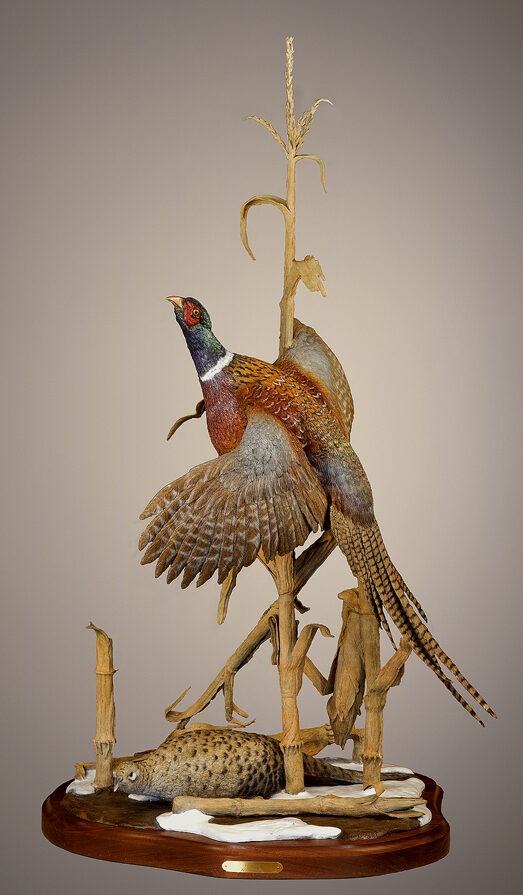
“Flushed” 49″ x 24″ x 24″
“I’ve seen him spend weeks to get the feather patterns for a goose right or the profile of a sheep curl. When you’re standing six feet away, you just don’t see it, but step closer and you appreciate the attention that Fred brings,” McNeil explains.
“Many contemporary sculptors have loose, flowing styles but they lack the hand’s-on knowledge of the animal that Fred possesses. Detail is his way of recognizing and honoring the beauty of an animal . . . celebrating the things that set it apart from other species.”

“Three Wise Men” 34″ x 25″ x 21″
Boyer’s intimate knowledge of his wild subjects is readily apparent in his sculpture, Three Wise Men. The bronze depicts three Rocky Mountain sheep resting on lofty pinnacle. Boyer, who has spent more than four decades guiding wild sheep and goat hunters, spent hours watching the trio as his client circled around the rocky crag to get a clear shot.
“The interesting thing about mountain goats is that it seems like whenever and wherever you see them, they are always looking down on you,” he explained. “That why I posed them in that fashion.”
A goodly number of Boyer’s creations are maquettes, which are works created at quarter scale of the original animal and then, using the sculptural process called “pointing up,” are grown to 1.25 life-sized. Autumn Royalty was first born as a maquette, another in Boyer’s big game series that has attracted art collectors from around the world.
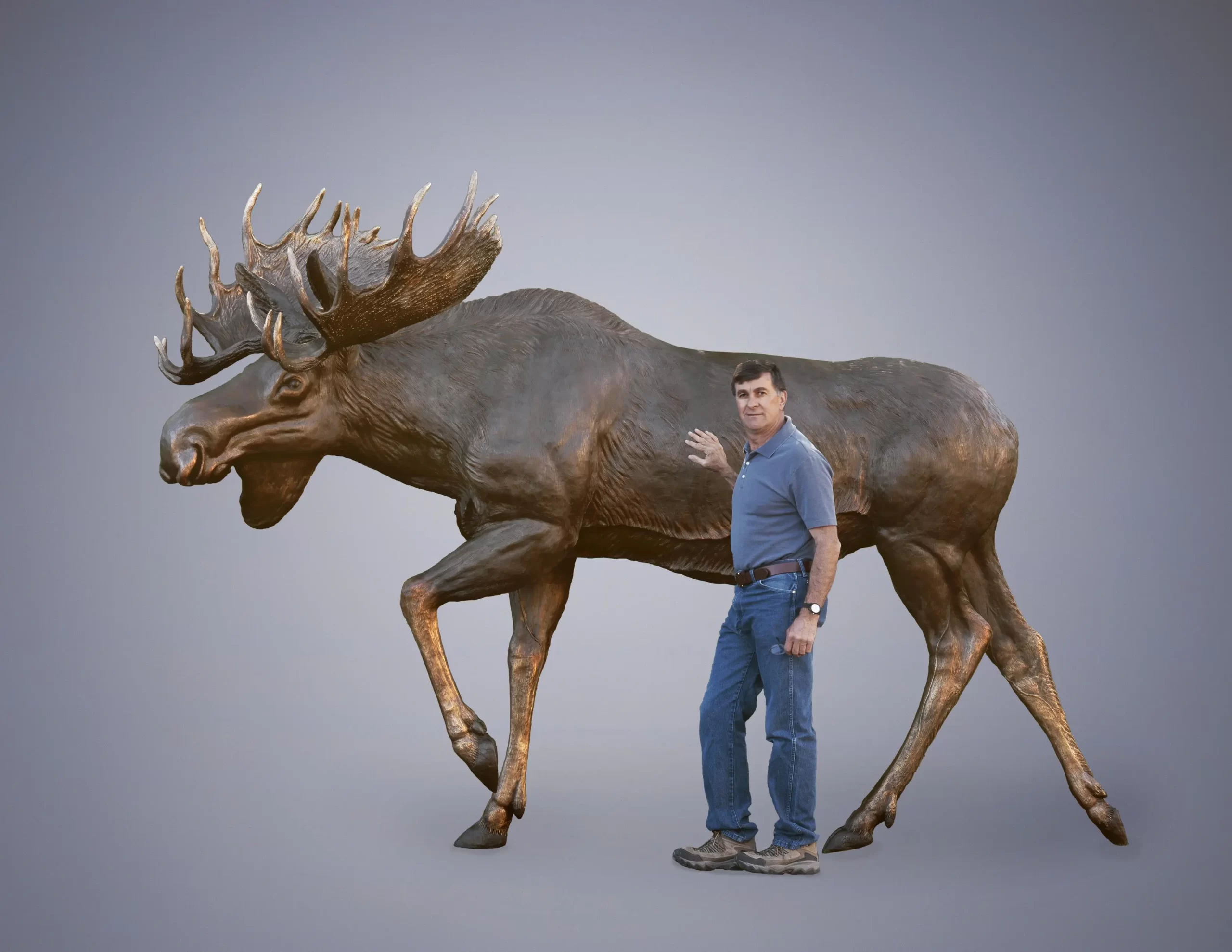
Five castings of Boyer’s acclaimed Alaskan Yukon moose monument, Monarch of the Stikine, today adorn public venues in the U.S. and Canada. One of the nine-foot-tall bronzes greets visitors at Cabela’s in Green Bay, Wisconsin.
Boyer is philosophical about the awe he holds for moose and elk that inspired the monuments.
“You’ve got a massive animal with a set of antlers that stretches several feet across. He’s in command of his surroundings; he’s earned his place among competitors vying for mates, and he can be as loud as he wants to be,” he says. “But then again, he’s usually not, and that has made him a survivor.
“In a second, he’s on the move and trying to be discreet, being as stealthy as he needs to be. He can slip through the timber without making a sound. I admire him because he’s just out there trying to make a living and stay alive. He doesn’t want you to know he’s there, but you can feel it.”
All of Boyer’s monuments are complicated feats of production at Valley Bronze, the full-service foundry in Joseph, Oregon, that delivered most of the decorative bronzes for the World War II Memorial in Washington, D.C.
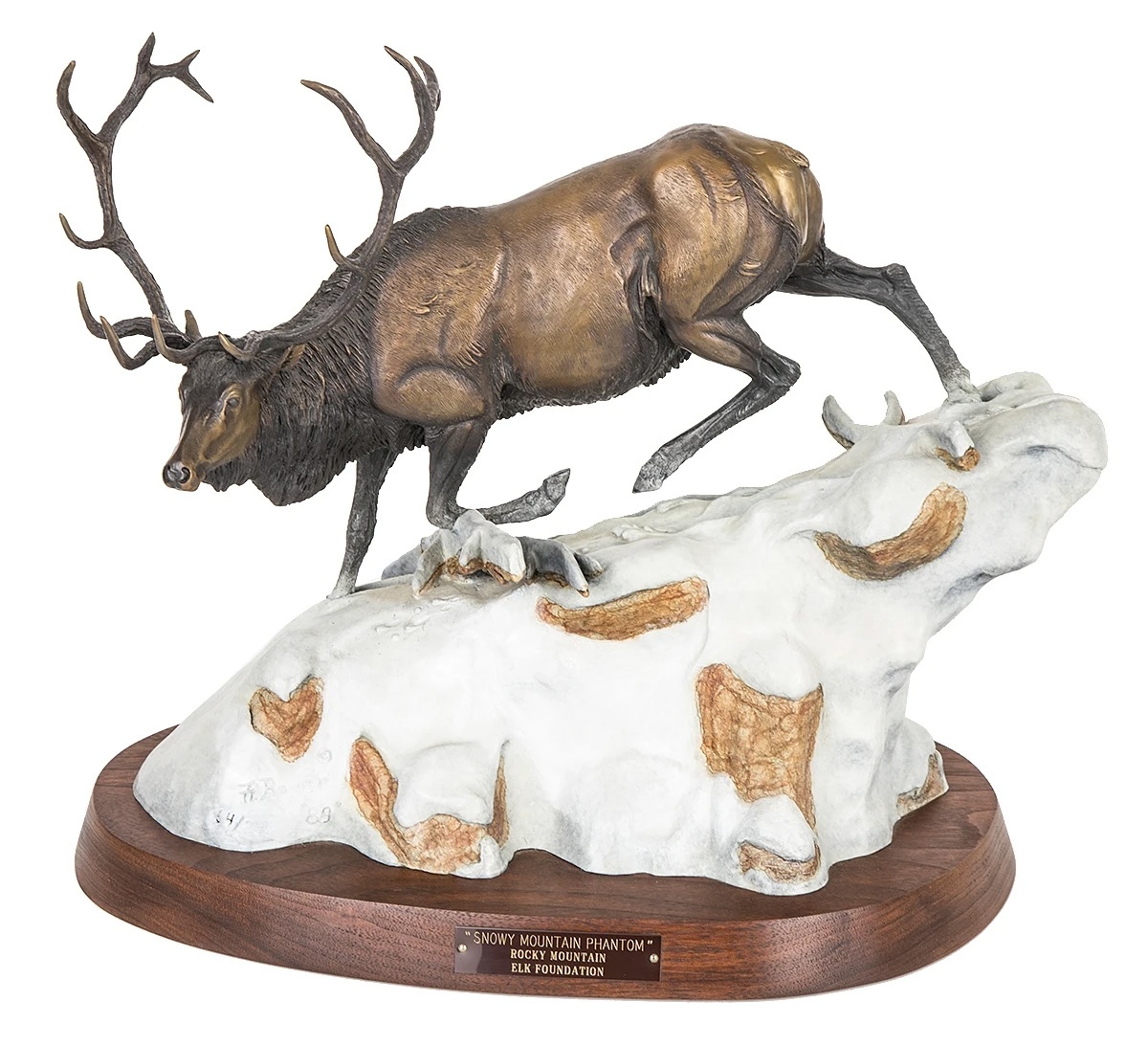
Years ago, Boyer’s small tabletop portrayal of mountain goats, titled Three Wise Men, sold for $11,500 at an SCI auction. As an indication of his appeal, Boyer produced an elk piece, shown above, in a special 100-run miniature edition for the Rocky Mountain Elk Foundation, and it sold out.
The same coveted status applies to his mountain sheep pieces, yet it’s actually a funny thing about Boyer and sheep. He has hunted Dall sheep in the sub-Arctic north and taken big rams, but in 44 years of putting in for a Montana sheep tag, he’s never drawn one.
“I’ve been on a lot of sheep hunts here with friends for several decades and helped them pack out animals. I was with a friend who killed a massive ram with his bow, but I’m still waiting for my chance. It may never come.”

Boyer’s son, Joe, did get a permit and ended up shooting a bighorn ram that scored more than 200 B&C points. He relives his son packing out the huge set of horns in his bronze, Breaks Magic. It was one of the largest bighorns ever taken in Montana’s Missouri Breaks.
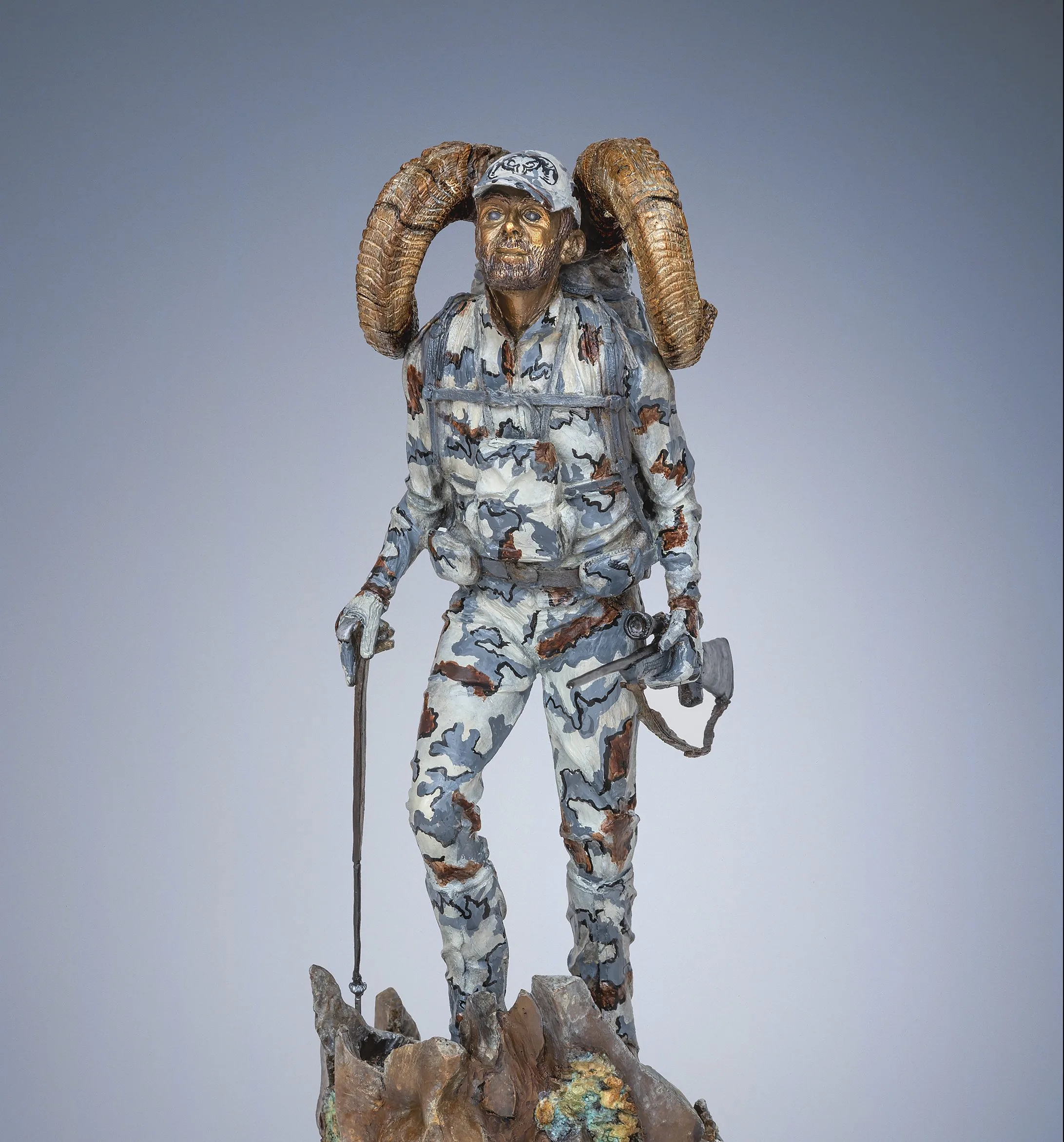
“Breaks Magic” 21.5″ x 12″ x 9″
In some spur ranges of the northern Rockies, sheep have disappeared and Boyer would rather that his sculptures raise awareness and, where possible, bolster conservation efforts spearheaded by the Wild Sheep Foundation. At several sporting and art events, Boyer’s pieces have won best of show honors and people’s choice awards.
Painter Trevor Swanson met Boyer on stage the same night that he received artist of the year honors from the Foundation for Wild Sheep, and Boyer earned rarefied distinction as “a living legend.” Ever since they’ve been comparing notes, sharing critiques and arranged to have booths next to each other at SCI’s annual exhibition.
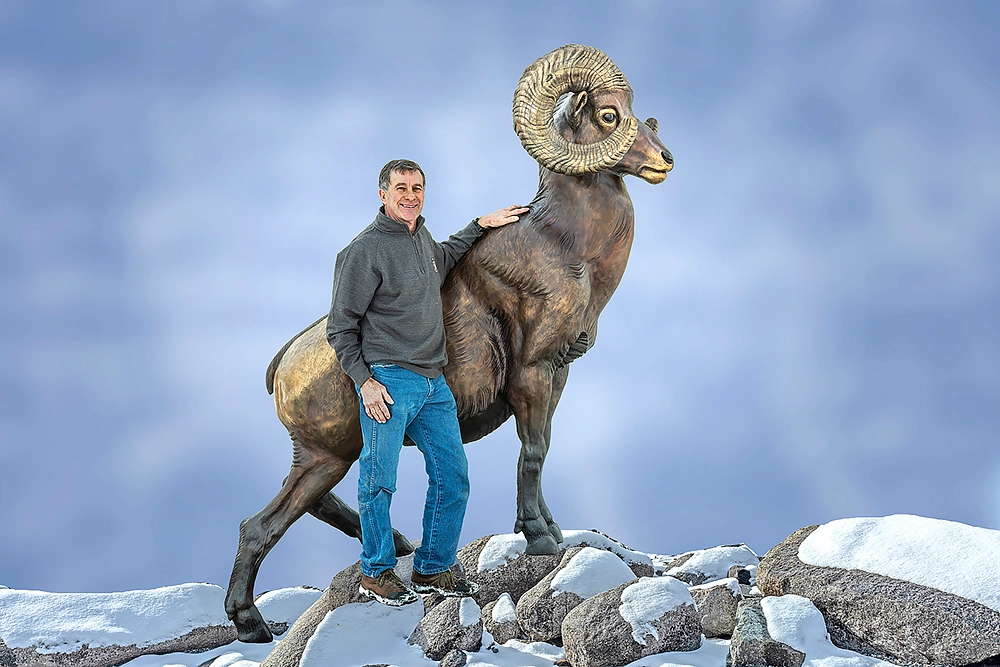
“King of the Mountain” 9’6″ x 6’6″ x 40″ | Edition 10
“Fred doesn’t do anything strictly to be marketable,” says Swanson. ”He has a deep sense of connection to his subjects. He has a sensitive touch when it comes to gamebirds, but to be honest, I’ve always gravitated toward his antlered animals, his elk and mule deer.
“Whether it’s a small piece or a monument, he captures the majesty of the animal. There’s something about the pose, the way his animals hold themselves, that make you want to touch his sculptures, feel the texture, and want to live in the moment that’s being portrayed.”
“I want to depict grandeur and grace,” says Boyer.” When I think about how strong and unique these creatures are, how they’ve been extensions of wild country going back thousands upon thousands of years, I don’t know what to say. That’s why I’m an artist. I don’t have a personal favorite.
“Very likely, if we’re ever out there together and looking at a moose or bear or goat or elk, I am likely to think: Isn’t that one the coolest animal there is?”
View Fred’s new work on his updated website at https://fredboyer.com/ where you can also browse his upcoming exhibitions, works for sale and more. If you are interested in a certain piece, send an email to fred.boyer.art@gmail.com.

